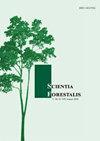气候季节性对三种休止林树种器官碳水化合物和细胞壁聚合物积累的影响
IF 0.4
4区 农林科学
Q4 FORESTRY
引用次数: 0
摘要
由于热带森林分布的环境千差万别,树种的生长受环境条件的制约。如果物种不表现出相当大的表型可塑性,其分布限制将会降低。然而,考虑到对气候变化的预测,环境可能会发生相对突然的变化,物种将不得不对新的条件做出快速反应。为了研究这如何影响植物组织中碳化合物的动态,对环境梯度的研究,结合气候的季节性分析,是一个强有力的工具。本研究的目的是评估分布在某休息林带的树种茎、枝、叶中非结构性碳水化合物和细胞壁聚合物浓度的季节变化(干雨期)。为此,我们分别在旱季(冬季)和雨季(夏季)对bahiensis、Guarea macrophylla和Calophyllum brasiliense种群进行了采集。淀粉和半纤维素浓度在雨季较低。然而,半纤维素浓度的降低是最均匀的结果。这些分子可能被用作该物种繁殖和生长所需的能量来源。由于长期干旱,其他非结构性碳水化合物(葡萄糖、果糖和蔗糖)没有表现出显著的变化。纤维素和木质素含量的微小变化归因于其他分子浓度的波动。一般来说,假设研究期间记录的低降雨量干扰了预期的季节性反应。这一现象可能减少了林区之间土壤湿度的差异。本文章由计算机程序翻译,如有差异,请以英文原文为准。
Influence of climate seasonality on the accumulation of carbohydrates and cell wall polymers in organs of three tree species of a restinga forest
Due to the great variety of environments in which tropical forests are distributed, the occurrence of tree species is conditioned to places that present favorable environmental characteristics. If the species does not show considerable phenotypic plasticity, its distribution limits will be reduced. However, given the predictions of climate change, environments may undergo relatively abrupt variations and species will have to respond quickly to new conditions. To investigate how this can influence the dynamics of carbon compounds in plant tissues, studies on environmental gradients, combined with seasonal analysis of climate, are a powerful tool. The objective of this study was to evaluate the seasonal variation (dry period-rainy period) in the concentrations of non-structural carbohydrates and cell wall polymers in stems, branches and leaves of tree species distributed in zones of a restinga (sandbank) forest. For this, we carried out collections in the dry season (winter) and in the rainy season (summer) in populations of Eugenia bahiensis , Guarea macrophylla and Calophyllum brasiliense . Starch and hemicellulose concentrations were lower in the rainy season. However, the reduction in hemicellulose concentrations was the most uniform result. Probably, these molecules were used as energy source in the reproductive and growth demands of the species. Due to a long period of drought, the other non-structural carbohydrates (glucose, fructose and sucrose) did not show significant variations. Small variations in cellulose and lignin contents were attributed to fluctuations in the concentration of other molecules. In general, it was assumed that the low rainfall recorded during the study interfered with the expected seasonal responses. This phenomenon may have reduced the differences in soil moisture between forest zones.
求助全文
通过发布文献求助,成功后即可免费获取论文全文。
去求助
来源期刊

Scientia Forestalis
Agricultural and Biological Sciences-Forestry
CiteScore
1.00
自引率
0.00%
发文量
39
期刊介绍:
Scientia Forestalis is a scientific publication of the IPEF – Institute of Forest Research and Studies, founded in 1968, as a nonprofit institution, in agreement with the LCF – Department of Forest Sciences of the ESALQ – Luiz de Queiroz College of Agriculture of the USP – São Paulo University. Scientia Forestalis, affiliated to the ABEC – Brazilian Association of Scientific Publishers, publishes four issues per year of original papers related to the several fields of the Forest Sciences.
The Editorial Board is composed by the Editor, the Scientific Editors (evaluating the manuscript), and the Associated Editors (helping on the decision of acceptation or not of the manuscript, analyzed by the Peer-Reviewers.
 求助内容:
求助内容: 应助结果提醒方式:
应助结果提醒方式:


